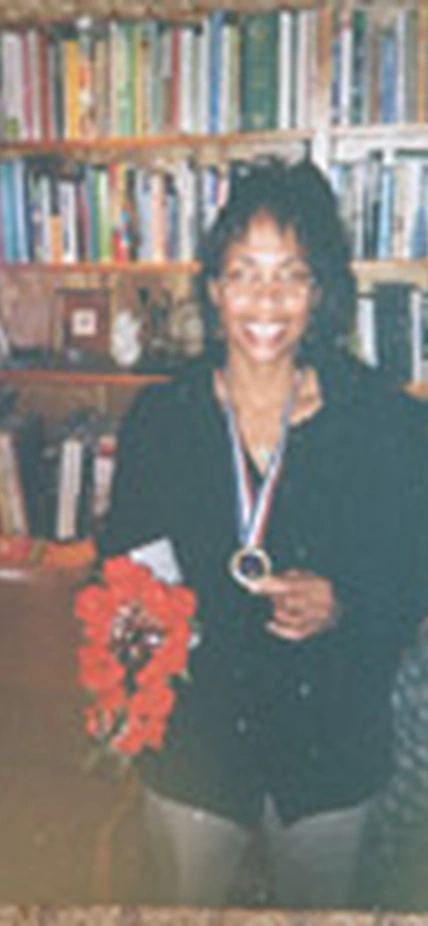Baltimore, MD—More than 25 years ago, Dianne Williams of Baltimore was hired by Carnegie’s Department of Embryology to wash lab dishes as part of a city job program for inner city youth. Now as head technician and manager of a Drosophila research lab, and with two degrees from Johns Hopkins University under her belt, she has authored four scientific papers published in prestigious journals and has been acknowledged for technical assistance on countless others. Genetics researchers in the Embryology Department and around the world have also benefited greatly from reagents she has produced. Carnegie president Richard A. Meserve will present her the Carnegie Service to Science Award on May 5, 2010, in Washington, D.C., in recognition of her unique contributions.
Williams did not wash dishware for long. Within a year of joining Embryology, she volunteered to take over the difficult and unpopular task of preparing the thousands of fly food vials needed weekly by Allan Spradling’s lab. The model fruit fly Drosophila melanogaster is used for genetics studies, including stem cell research and research into the development of egg and sperm. Williams was in awe of the graduate students and postdoctoral associates around her. That didn’t deter her from asking a lot of questions, though. She wanted to know about food problems that the researchers encountered so she could find ways to improve the fly diet. Soon the flies in the lab were happier than they had ever been.
Much of the fly food is used by the lab’s stock technician, who maintains the Spradling group’s collection of mutant strains. The person carrying out this job must understand genetics and work with great care to maintain the integrity of the genetic stocks on which lab research depends. This requires that they recognize dozens of mutant appearances and behaviors in the tiny fruit fly. Williams was a quick learner and within a few years had moved into this position. She began to pepper researchers with questions about their molecular biology experiments and soon was helping prepare the reagents needed for such work.
Taking advantage of Carnegie’s educational benefits, Williams attended Johns Hopkins at night for eight years, ultimately earning a B.S. That education provided a foundation for her to undertake molecular biology experiments at the lab and that experience allowed her to become a research technician assisting others with their experiments. Soon her name began appearing in the acknowledgement section of scientific papers.
Williams next decided to enter graduate school in molecular biology, again at night while working days at Carnegie. She began several research projects that were eventually taken over by postdoctoral fellows and greatly prospered. For her own research, she investigated the effects of transposable elements, so-called jumping genes, when they enter and leave the repetitive DNA sequences that make up much of animal genomes from flies to humans. Discovered by Carnegie’s Roy Britten, these “repetitive DNAs” change rapidly in animal genomes, and Williams’s research suggested that transposons play a role in this evolution. Williams’s work ultimately resulted in a publication as lead author in the Proceedings of the National Academy of Sciences and a Master’s Degree.
A few years ago, the Spradling lab began to run low on a critical antibody that recognizes a protein called Vasa, the first protein found that is common to the germ cells of all animals—the cells that give rise to egg and sperm. The lab studies germ cells and used this antibody extensively to identify developmental processes. They relied on the generosity of Paul Lasko of McGill University to provide it. Williams decided to rectify this situation. She generated two new Vasa antibodies of exceptional quality, including a “monoclonal” antibody that now provides an unlimited supply. As a result, the lab was able to handsomely repay Lasko’s generosity, and submit Williams’s reagent to a public repository where it is widely distributed to researchers around the world.
“Even in an institution filled with uncommonly talented and interesting people, Dianne Williams is truly special,” said Spradling. “She has contributed immeasurably to the successes my lab has enjoyed over the years, and to the day-to-day pleasure of working there. Countless times I have thanked my good fortune that our department decided to give a young kid a chance back in 1983.”
Carnegie president Meserve stated that he is “enormously proud of the fact that the Carnegie Institution has been able to nurture the career of this budding scientist.” He said that “she is an exceptional example of the dedicated staff that enhances our scientific activities.”
--------------------
Papers by Dianne Williams:
Cooley, L., Thompson, D. and Spradling, A.C. (1990). Construction deletions with defined endpoints in Drosophila. Proc. Nat. Acad. Sci. USA 87, 3170-3173.
Thompson-Stewart, D., Karpen, G.H. and A.C. Spradling (1994). A transposon can drive the concerted evolution of tandemly repetitious DNA. Proc. Nat. Acad. Sci., USA 91, 9042-9046.
Tulin, A., Stewart, D. and A.C. Spradling (2002). The Drosophila heterochromatic gene encoding poly(ADP-ribose) polymerase (PARP) is required to modulate chromatin structure during development. Genes and Develop. 16, 2108-2119.
Kai, T. , Williams, D. and Spradling, A.C. (2005). The expression profile of purified Drosophila germline stem cells. Develop. Bio. l 283, 486-502.
